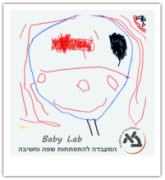Language and Cognitive Development
The drawing at the top was drawn by my middle-daughter, when she was 4-years old. She showed it to me on that occasion, and I asked her, "what is it?" She replied, "This is a girl, and this [horizontal red] line is her forehead." I followed it up and asked, "What are the red and black blots above her forehead?" To which she responded: "The red one is her happy thoughts; the black one is her dream of a witch."
We can't really read children's minds, even when they are graphically depicted to us. Instead, if we want to know how they think, and what they think about, we need to design specific experimental tasks that allow us to indirectly get a glimpse of their reasoning. At the Language and Cognitive Development Lab at Bar-Ilan University we develop and conduct such studies. Gaining a better grasp of children's minds helps us not only better understand children, but in fact, tells us a lot about how we come to have the minds that we do as adults.
Research Fields
Research Methods
Last Updated Date : 14/10/2020




